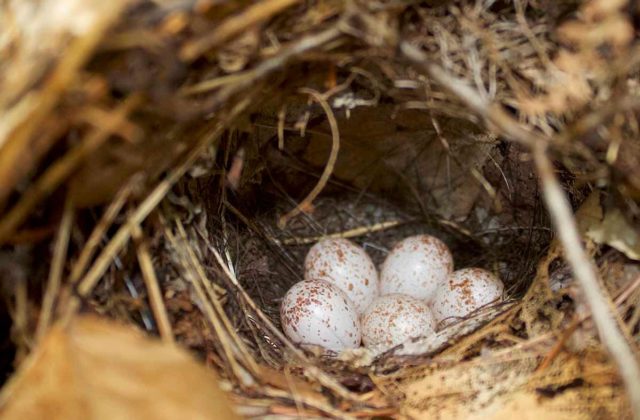Ovenbird: Summer Songster
By Susannah Wood
There is a singer everyone has heard,
Loud, a mid-summer and a mid-wood bird,
Who makes the solid tree trunks sound again.
—Robert Frost
Even if you are not a birder but find yourself anywhere near the Norfolk woods come late April or early May and on into summer, you’re sure to have heard “Teacher! Teacher! Teacher!” ring out. Call more than song, this is the territorial weaponry of the ovenbird (Seiurus aurocapilla), a small neotropical warbler about the size of a song sparrow. If you wander into the forest and are very lucky, you may even see an ovenbird nest at your feet. It resembles an old-fashioned brick oven, with its domed interior and arched opening, an item in common use in the 1820s when the name “ovenbird” was coined. It’s a tiny marvel, only 3 inches by 2 inches on the inside, fashioned of grass, stems, dry leaves, pine needles and lined with deer hair, a roofed cradle almost invisible from above.
Ovenbirds look a bit like miniature hermit thrushes with olive-green backs and tails and white breasts streaked with dark dashes. (Hermit thrushes have browner backs, reddish tails and round spots on the breast.) A bright orange crest edged in black is another distinguishing feature, reflected in its species name, “aurocapilla,” meaning “golden-haired.” While both species forage on the ground, the ovenbird walks, often flicking its tail, while thrushes hop. (“Seiurus” comes from the Ancient Greek words for “shake” and “tail.”)
You won’t find ovenbirds in the suburbs. They require unbroken forest to nest in where the trees are 50 to 70 feet high with a thick layer of leaf litter harboring plenty of spiders, snails, caterpillars, beetles as well as a good nesting material. According to the Cornell Lab of Ornithology, ovenbirds may need access to forest parcels greater than 2,000 acres. No wonder Norfolk is such a good place for them.
The female chooses an upland site, below or adjacent to an opening in the canopy. The additional light encourages shrubs and flowering plants, good cover for adults and young. She builds the nest up around her from the inside, aims the opening downhill, and shrouds it with dead leaves melding it with the forest floor. The three to six eggs, white with speckles, hatch after two weeks. When the nestlings are eight days to ten days old, they venture forth one by one over the course of a day. Then the family splits up. Some stay with the male, remaining in the nesting grounds; the others follow their mother to a nearby area. At thirty days old they are fully self-sufficient. Summer is short and everything has to happen fast.
It’s a dangerous world for ovenbirds. Not surprisingly, eggs and nestlings are vulnerable to hungry raccoons, snakes, skunks, weasels, squirrels, blue jays, chipmunks, and, of course, domestic and feral cats. (It’s estimated that cats kill one billion songbirds every year.) Owls and hawks also pose a threat. Earthworms and red worms native to Europe have been advancing into Northeastern and Midwestern forests changing those forests dramatically by reducing leaf litter and disrupting the entire forest floor ecosystem that has evolved in the wake of glaciation. That does not seem to be a problem here as yet, perhaps thanks to our rocky soils. Along with white-throated sparrows, ovenbirds are the most numerous species to be killed in collisions with skyscrapers and towers. Forest fragmentation not only reduces nesting habitat but brings more parasitism by brown-headed cowbirds. Acidification of soils due to greenhouse gases leaches calcium essential for egg shells. When Dutch elm disease tattered the forest canopy in the Midwest, ovenbird populations declined. What will the emerald ash borer’s arrival mean for our ovenbirds? For now, ovenbirds appear to be holding their own. Long may we hear our mid-summer and mid-wood bird.
Photo, top, of an ovenbird nest on the forest floor, by Wiley Wood.

